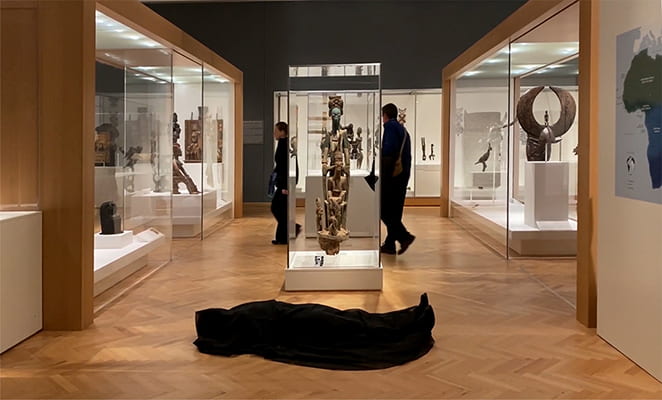
Sanctuary (2019)
Video, installation, sculpture and performance
Dimensions Vary
Click here to view accompanying video piece
Click here to view video documentation of performance
In this piece, I explore themes of cultural displacement, history and seeking belonging, by investigating the ways in which African and African-diasporic people create spaces of relaxation, restoration, and disruption.
Silence is a woman (2019)
Dutch wax fabric, print, installation
Dimensions Vary
Click here to view video piece
In this piece, I explore avenues for East African women to organize and create spaces of solidarity against patriarchal ideology. I do this by printing text from Silence is a woman, an essay by Wambui Mwangi, on 6 pieces of 1 x 2 yards of Dutch wax fabrics, essentially replicating the form of the Khanga, a common piece of fabric worn by women in East Africa.

Remember the conquests (2020)
Performance
Dimensions Vary
Click here to view video
I use performance to intervene within the African Art section of the Art Institute of Chicago, and to challenge the ethnographic style of display accorded to African artifacts.
Amorphous Being: An Artifact (2020)
3D animation, sound (work in progress)
Dimensions Vary
Click here to view video piece
In this piece, I use 3D animation and sound to construct a character, and space, which explores the anxieties of loss of memory and history, and therefore exploring the historical aspect of identity.
Artist Statement
My installations are composed of objects and images that have I appropriated from Kenya and the United States; objects such as East African fabrics, soil and cleaning utensils. These objects are altered materially, in ways that highlight them as markers of African femininity and of indigeneity. They are also altered contextually, by combining them with other media in installations, such as performance, video and even print. I use these methods to construct spaces that comment on the resilience of African women in finding ideological spaces of belonging and collective autonomy in the presence of hegemonies like colonialism, western exceptionalism and patriarchal ideology.
My recent body of work appropriates the ethnographic museum space and investigates the vestiges of colonialism still prevalent in the style of display accorded to continental African artifacts. I use performance to insert the body as artifact into the space, which, by construction, lacks such an intervention. I also use 3D animation to create fantastical, sentient, amorphous African artifacts who have challenges in defining their own identity. I use these practices to raise questions on the internal/external perceptions of identity, especially in finding autonomy in the wake of suppressive sociological power systems.
In appropriating existing spaces, I challenge the intentions that go into creating and sustaining such spaces, especially when those intentions are masks of hegemonic histories and narratives. In creating spaces of my own, I explore the possibilities of radical spaces: spaces that soothe and heal, as well as provoke and protest. I, therefore, use art to question the power dynamics of creating a space.




